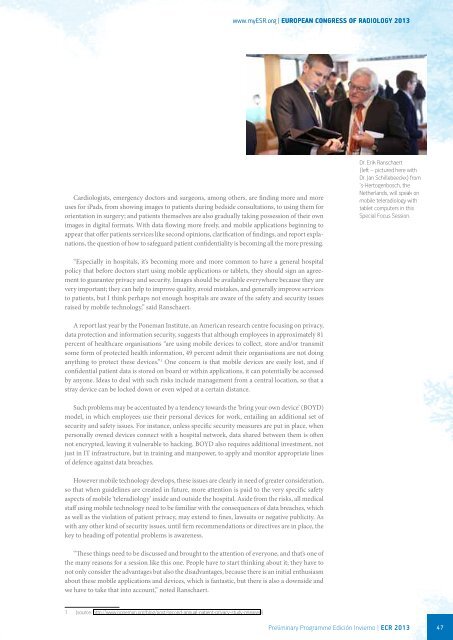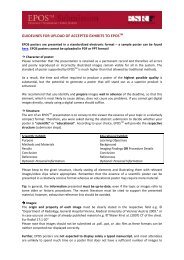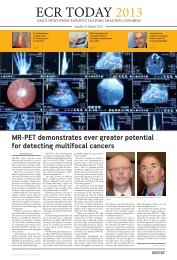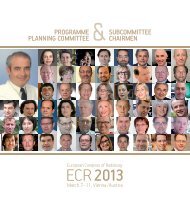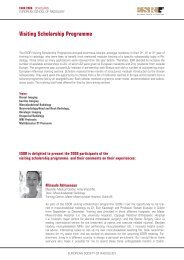New Horizons - myESR.org
New Horizons - myESR.org
New Horizons - myESR.org
- No tags were found...
Create successful ePaper yourself
Turn your PDF publications into a flip-book with our unique Google optimized e-Paper software.
www.<strong>myESR</strong>.<strong>org</strong> | EUROPEAN CONGRESS OF RADIOLOGY 2013Cardiologists, emergency doctors and surgeons, among others, are finding more and moreuses for iPads, from showing images to patients during bedside consultations, to using them fororientation in surgery; and patients themselves are also gradually taking possession of their ownimages in digital formats. With data flowing more freely, and mobile applications beginning toappear that offer patients services like second opinions, clarification of findings, and report explanations,the question of how to safeguard patient confidentiality is becoming all the more pressing.Dr. Erik Ranschaert(left – pictured here withDr. Jan Schillebeeckx) from‘s-Hertogenbosch, theNetherlands, will speak onmobile teleradiology withtablet computers in thisSpecial Focus Session.“Especially in hospitals, it’s becoming more and more common to have a general hospitalpolicy that before doctors start using mobile applications or tablets, they should sign an agreementto guarantee privacy and security. Images should be available everywhere because they arevery important; they can help to improve quality, avoid mistakes, and generally improve servicesto patients, but I think perhaps not enough hospitals are aware of the safety and security issuesraised by mobile technology,” said Ranschaert.A report last year by the Poneman Institute, an American research centre focusing on privacy,data protection and information security, suggests that although employees in approximately 81percent of healthcare <strong>org</strong>anisations “are using mobile devices to collect, store and/or transmitsome form of protected health information, 49 percent admit their <strong>org</strong>anisations are not doinganything to protect these devices.” 1 One concern is that mobile devices are easily lost, and ifconfidential patient data is stored on board or within applications, it can potentially be accessedby anyone. Ideas to deal with such risks include management from a central location, so that astray device can be locked down or even wiped at a certain distance.Such problems may be accentuated by a tendency towards the ‘bring your own device’ (BOYD)model, in which employees use their personal devices for work, entailing an additional set ofsecurity and safety issues. For instance, unless specific security measures are put in place, whenpersonally owned devices connect with a hospital network, data shared between them is oftennot encrypted, leaving it vulnerable to hacking. BOYD also requires additional investment, notjust in IT infrastructure, but in training and manpower, to apply and monitor appropriate linesof defence against data breaches.However mobile technology develops, these issues are clearly in need of greater consideration,so that when guidelines are created in future, more attention is paid to the very specific safetyaspects of mobile ‘teleradiology’ inside and outside the hospital. Aside from the risks, all medicalstaff using mobile technology need to be familiar with the consequences of data breaches, whichas well as the violation of patient privacy, may extend to fines, lawsuits or negative publicity. Aswith any other kind of security issues, until firm recommendations or directives are in place, thekey to heading off potential problems is awareness.“These things need to be discussed and brought to the attention of everyone, and that’s one ofthe many reasons for a session like this one. People have to start thinking about it; they have tonot only consider the advantages but also the disadvantages, because there is an initial enthusiasmabout these mobile applications and devices, which is fantastic, but there is also a downside andwe have to take that into account,” noted Ranschaert.1 (source: http://www.ponemon.<strong>org</strong>/blog/post/second-annual-patient-privacy-study-released)Preliminary Programme EdiciÓn Invierno | ECR 2013 47


